Ani Gosha’s Story
By Ani Gosha
Buddhistdoor Global
| 2015-02-06 | 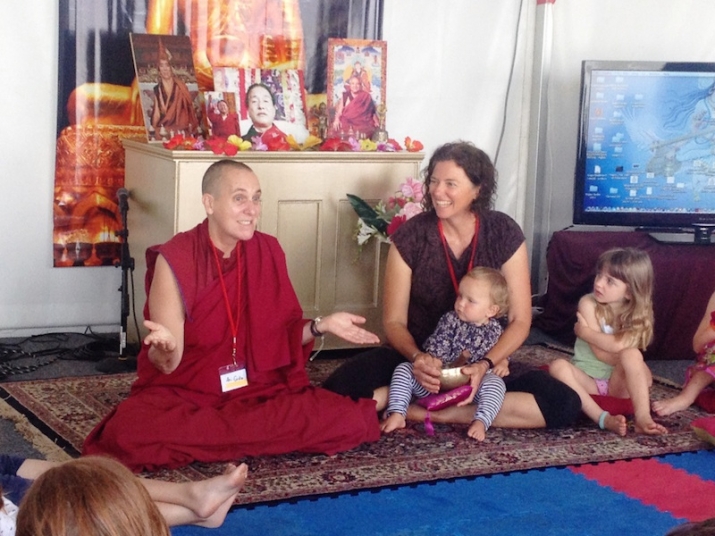 At Sogyal Rinpoche’s Myall Lakes retreat 2014, doing a “show-and-tell” for the children: What is a Buddhist nun?
At Sogyal Rinpoche’s Myall Lakes retreat 2014, doing a “show-and-tell” for the children: What is a Buddhist nun?Parts of this story I have told many times to friends and to strangers, both. It gives me much pleasure to recall it and to share a little, again.
How I found the Dharma . . .
My drama teacher at high school was a great mentor—his course included introductory philosophy and Zen Buddhist koans along with basic visualization and relaxation techniques. I learned then that you didn’t die if you thought “outside of the box,” even tho’ your family—and maybe even sometimes you yourself—thought you might be going crazy!
My tertiary education got off to a rocky start—six months into my Diploma of Teaching I had a motorbike accident. I am eternally indebted to the truck-driver who I “met” that day. He had just completed a St. John’s Ambulance course, and he saved my life. That near-death experience affected me in a deep way; however, it was many years before I could put it into perspective. At the time, I was just focused on “getting my life back.”
Ten years later, having finished my teacher training, my husband and three beautiful children and I were living the hippie life and building our own home in the bush, way to the west of Nimbin, the rainbow capital of Australia. But life was rocky; the poverty and hard work of pioneering were shaking our dream . . . When a call came from my brother-in-law—he was dying of cancer and needed support—we went to live with him. He died at home, with the support of family and his wonderful community of friends.
Within three years my little family was again giving support—this time to my mother-in-law, who also died of cancer. She was the rock in our lives, so these were traumatic times. Needing to regain our ground and a little weary and shaken, we went back to the bush and our community.
It was then that a friend, who is a nurse, told me about The Tibetan Book of Living and Dying. In it I found the words which described not just how I felt, but what I needed to know about what I felt. That book also gave a context for the dying experiences I had witnessed, as well as for my own near-death experience.
Looking back, there were two “keys” in that book for me which make me smile every time I remember them. The first was a picture of Dilgo Khyentse Rinpoche, one of Sogyal Rinpoche’s teachers. I would think to myself, “I need to read a bit more of that book . . .,” but somehow I would just find myself looking at his picture. I know I cried when I first saw the dates under it and realized that he had already died.
The other part which caught me was a section on purification. The note accompanying this presented the Hundred-syllable Mantra in Sanskrit. I clearly remember my first attempt at trying to say this jumble of letters, and thinking—my first aspiration, perhaps—“I need someone to teach me this!!!” Within a year, I had started studying with Sogyal Rinpoche’s Beginner’s Program.
My great fortune was that I was again living in the bush west of Nimbin, in the small country town of Kyogle, which was then home to a small but flourishing Tibetan Buddhist community and retreat center, Vajradhara Gonpa. I had known about the gonpa for more than 15 years, but it was only through Sogyal Rinpoche that I finally went “up the hill” and began to learn more about the Buddha’s teachings. Around that time, many short courses were being offered at the gonpa, and many teachers were coming to visit. The first Tibetan lama I met—when I was helping in the kitchen for a five-day retreat—was Jetsun Kushok, the sister of His Holiness Sakya Trizin.
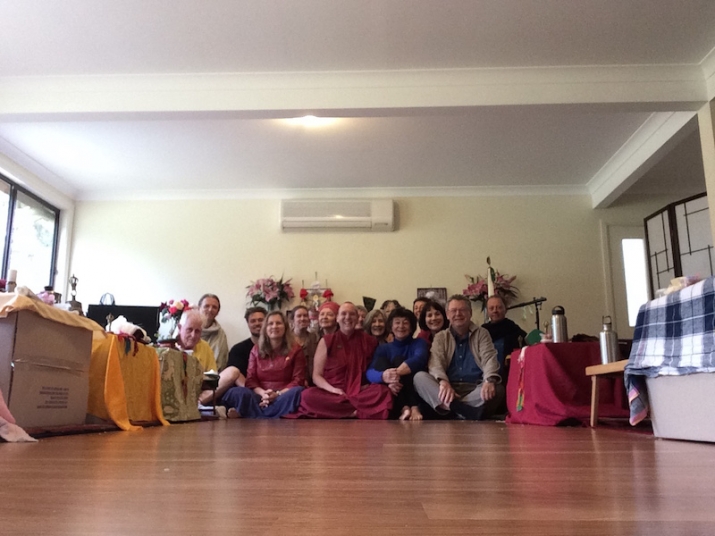 Drupcho in 2014 near Sydney
Drupcho in 2014 near SydneyWhy I followed the teachings . . .
I instinctively knew that I had to keep following the teachings—I had been searching my whole life, trying yoga, different healing modalities, and every New-Age-y thing going, but with Buddhism I felt I could engage with my heart AND my head—I could be true to myself and train my mind at the same time.
It was a challenging time for those around me—I didn’t have any doubt that I was going to follow this through, but my family and close friends were a little shocked and dubious. Was this some sort of cult? How long would I last? My husband’s reticence challenged me to focus on what was important—for me. I have to say this was a selfish time, but self-oriented in that I knew I needed to do “this” (whatever it was going to be) for my own sanity and well-being.
One of our conversations—one of those direct, no-holds-barred, bare-faced-and-a-little-scary conversations—was about dying. He was asking me why I was doing this, what was in it for “us” as a couple and a family. Having the fresh experiences of helping his brother and his mother through their dying, and fueled with the little I had gleaned from the courses I had done, I said, “I want to be ready when I die.” Then I asked him, “If you KNEW you were going to die tomorrow, what would you do?” To his credit he only gulped a little, and then said, “Go to church!”
I tried to make the point at the time that I wasn’t trying to stop him from finding out what it was that he needed to know, or to stop him from finding “his own truth”—I would have been truly happy if he had decided to go to church then; but in the context of our relationship at that time, it was just too much to deal with and, with the help of the Buddhist teachings, lots of breathing meditation, and support from old and new friends, gently we finished that chapter of our relationship. Fifteen years later we are good friends, parents and grandparents together, but I don’t know if he has been to church . . .
The Buddha’s teachings made it clear to me that it was my mind that was the force that made me happy or sad, my mind that chose whether I would be angry—or not. So I chose to follow a path that kept my mind on its toes, that required me to change if I truly wanted happiness. And I didn’t just want it, I needed it—and not just for myself, but for everyone I knew and loved; and even for the “everyone” I didn’t know, or really quite love.
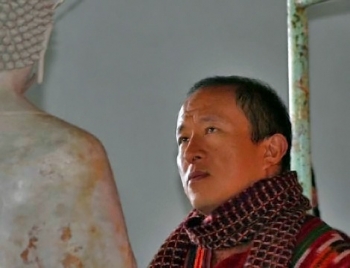 Dzongsar Khyentse Rinpoche. From khyentsefoundation.org
Dzongsar Khyentse Rinpoche. From khyentsefoundation.org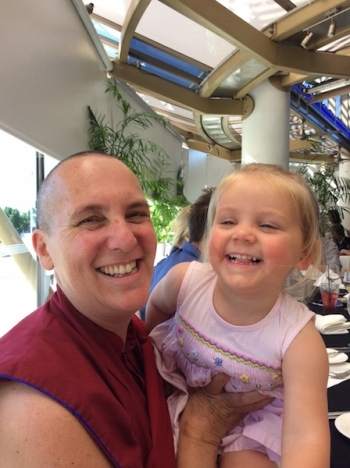 With my youngest granddaughter, Emma
With my youngest granddaughter, Emma Meeting Dzongsar Khyentse Rinpoche . . .
Dzongsar Khyentse Rinpoche is elusive. I was a student at the gonpa, where he was the abbot, for almost two years before I met him. He visited irregularly, but provided the guidance for programs and was instrumental in inviting visiting teachers. It just seemed that what needed to happen would happen at the time it was supposed to. I was studying, meditating, talking with like-minded people and definitely getting happier, and I was confident that I was in a good place, physically, mentally, and spiritually.
As part of the continuing program at the gonpa, Tenzin Palmo (the British-born Buddhist nun) was invited to teach for a weekend, so I was there as a matter of course. When she offered to give the Refuge vows to new students, it was suggested I could do this, so although I didn’t really know what to expect, it seemed like a logical progression.
Dzongsar Khyentse Rinpoche came to the gonpa the very next weekend, and also offered to give Refuge. This time I had no doubt—this was the next step—and in terms of what, in the Buddhist teachings, are called the Five Perfections, I had found them: the Perfect Place, the Perfect Teaching, the Perfect Teachers, the Perfect Time, and I was working on being the Perfect Student.
It was at that time that I received the name Gosha. In Shantideva’s book, The Way of the Bodhisattva, one of the names of the bodhisattva Manjushri is “Manjugosha.” This means “He of Melodious Speech,” so “Gosha” means “melody.”
Taking ordination . . .
There was never a point at which I decided I wanted to be a nun—it was almost the opposite!
One of the early conversations I had with my husband went a bit like this. He was totally exasperated that all I wanted to do was to find time each day to sit and meditate, and said, “You're going to be a monk, aren’t you!” For me, this question came totally out of left field—I was stunned by his acrimony and then stunned by the instant reaction of my mind, one half of which was saying, “No way!!,” while the other half was saying, “It’s a ‘nun,’ actually!”
This question came up quite a few times, from different people, and finally, in 2003, after a friend asked yet again, “Are you going to be a nun?,” I realized that I truly didn’t know the answer. So I asked Dzongsar Khyentse Rinpoche. At that point I had no preference, so whichever answer he gave would have been fine. But Rinpoche did a divination of some sort and then bestowed the rabjam or first level of vows; he gave me permission to wear robes, and my daughter and a friend cut my hair.
Seven years later, in 2011, when I was in Bodhgaya studying with the incarnation of Dilgo Khyentse Rinpoche, I was given the full novice vows by Khenpo Yeshe Gyaltsen. As a Westerner and not living in a nunnery, the vows of a novice are what I can manage. This means I manage my own finances, spend time with family, and travel to be with my teachers. It is what I am able to do right now.
Personally, I have never felt that the vows have “restricted” me. I have not had any formal “training” as such in how to be a nun—I read The Words of My Perfect Teacher by Patrul Rinpoche, and later, The Way of the Bodhisattva by Shantideva, and worked it out from there. I found an early piece of advice to be the best—and I will have to paraphrase as I don’t have it here right now—which is, if the vows are seen as restrictions they will be like a noose, but if they are seen to be guidance for the path they will be like an ornament . . .
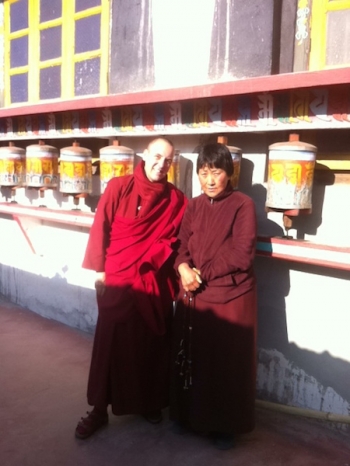 At Zangdokpalri Monastery in Kalimpong—the first Tibetan Buddhist monastery outside Tibet, built by HH Dudjom Rinpoche in 1946
At Zangdokpalri Monastery in Kalimpong—the first Tibetan Buddhist monastery outside Tibet, built by HH Dudjom Rinpoche in 1946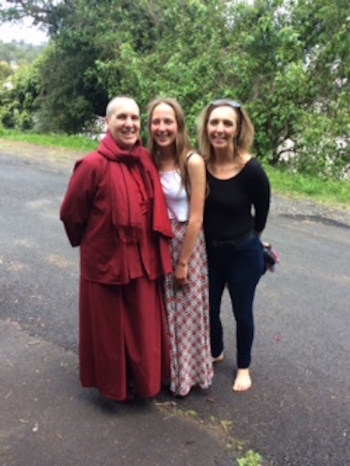 With my eldest daughter and her eldest daughter
With my eldest daughter and her eldest daughter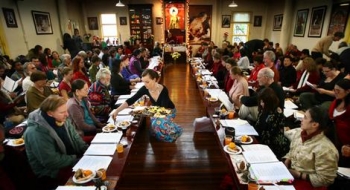 Conclusion of the first three-year retreat at Vajradhara Gonpa. From www.theage.com.au
Conclusion of the first three-year retreat at Vajradhara Gonpa. From www.theage.com.au Three-year retreat . . .
In January 2005, I was fortunate to be part of the first three-year retreat program at Vajradhara Gonpa. The progression to that point had been steady, relentless, and breathtaking, for me as well as my family. Truthfully, I had no idea what was involved—probably if I had, I would not have even dared to contemplate it—it is certainly no holiday!
You might know how it is when . . . Well, for me there is that moment when I just really want to tell someone how it really is . . . to be able say what is really going on. . . . When my eyes are brimming with tears and my nose goes red. When I can’t breathe, for crying. . . . In three-year retreat, those moments come quite often—but who is there to tell? You sit on your bed or your cushion and that’s it—you are “it.” And then, because your prayers are what you work with all day, I would be telling all the teachers I had ever come in contact with, and telling the Buddhas and bodhisattvas, too.
Being in that moment—desperate, despairing, totally with my own “stuff,” it was like—and I say here, it still is like—if I can keep the truth of that pain in front of me and hold it up, face it, get to know it and stay with it a little, remember to breathe . . . then slowly, bit by bit, it doesn’t hurt quite so much. Slowly, I see myself in that moment, and if I get some relief or space around it, I may feel a little smile in my heart or around my mouth. Then I can start to remember the precious moments I have had with my teachers, the ones who encourage me to go through this. So gradually, through this process I am getting to know these moments, to know myself and to know my teachers a little more.
Intellectually, if I analyze, of course I am just telling myself. And to look on this level, of course I am telling the one person who really knows and understands how it is and how it feels— me. There is no room for mixed messages; no misinterpretation; no gap—I just put it how it is—the bare, naked truth. It’s tough to trust yourself enough to go there, but sometimes it just happens. And that is okay; good, even. Retreat helped me with that.
Post-retreat . . .
Mainly, what I see my as “job” post-retreat is to carry the Buddha’s flag. I wear the robes for the people I see and come into contact with every day—so that they can make a connection with the teachings of the Buddha. Sometimes it means they cross the road just to come and stand next to a monk (many in the West don’t know that a female in robes is a nun!)—or they might cross the road to get out of the way—but in either case there is a connection, and as it says in
Samantabhadra’s Aspiration Prayer, I hope they may they find the teaching that suits them best.
I said earlier that Dzongsar Khyentse Rinpoche was elusive—for me, that means he doesn’t give me directions or tell me what I should be doing! In the years I have been his student and a nun, he has never really given me a job to do as such. When he bestowed the rabjam vows and said I could wear the robes, there were no other guidelines or instructions—it was just, well, go and work it out! Do it! And it is that trust that keeps me going—I trust that he trusts me to do my best . . . And so that is all I can do. I do my best . . . all the time.
This article is one of a series on how Buddhism has impacted the lives of practitioners. We welcome you to send us your story as well.






















